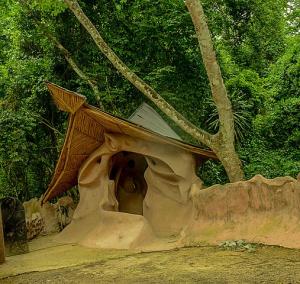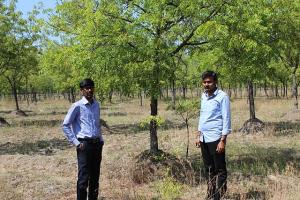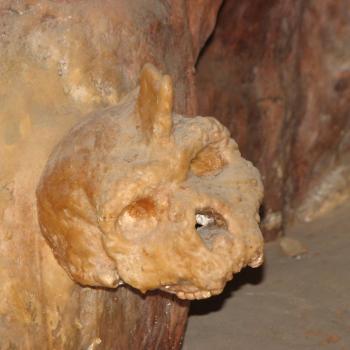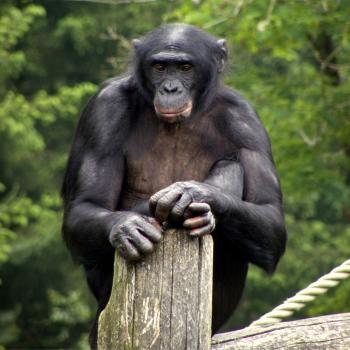From the viewpoint of an environmental reclamation engineer, the sacred groves of the ancient world were a highly effective method of maintaining a healthy ecosystem and a clean water supply over the long term. Often located on the outskirts of a village, sacred groves typically featured shrines built along a serpentine river.
In Nigeria, a Yoruba legend recounts the voice of Osun the river goddess warning early settlers not to cut down her trees. The settlers heeded her warning and established the city of Osogbo on higher ground, while dedicating the forest to the river goddess. Today the Osun Sacred Grove is preserved together with 40 shrines along the snaky river.

Traditional healers gather medicinal plants in the grove, but hunting, fishing, and farming are prohibited. Thousands attend the Osun Festival every August to celebrate the peaceful and enduring cohabitation of the Osogbo people and the Yoruba goddess. UNESCO established the Osun Sacred Grove a World Heritage site in 2005, citing it as one of the last intact examples of a once-common feature in African villages.
Saving sacred groves in China
In China a series of industrial, developmental and cultural pressures have eroded the number and size of sacred groves and challenged the local belief systems that protected them. The flight of youth from rural to urban areas and the introduction of media communications technology has further weakened local cultures.
A pilot project entitled, “Ethnic Eco-cultural Village” was launched in 2002 by Yunnan University and the Ford Foundation to bolster and reinforce the concept in six villages across Yunnan Province. The project has helped the Sani people maintain sacred groves where they worship Mizhi, a god associated with protection, prosperity, and bountiful harvest.
A festival culminating on the winter solstice is held each year between Nov 22 and Dec 22, emphasizing the ongoing guardianship of the groves and related laws and practices. A Villagers’ Committee identified sacred sites and places of worship and built environmentally respectful pathways to connect the sites. They also established financial penalties for breaking rules in the grove. In 2005, the pilot project at Yuehu Village was among the first to be included in the Shilin county government’s program of ethnic eco-cultural tourism.
Sacred groves and karma
A similar tradition of protecting sacred groves has been more successful across India, where about 14,000 sacred groves have been reported. The groves of India were established by Hindus, Buddhists, and Jains, complete with temples, shrines, and burial grounds.
The Vrikshayurveda, a 10th century Hindu text, states that planting and raising trees is a karmic contribution to inter-generational balance. The sacred groves of India are associated with religious ceremonies, festivals, the planting and nurturing of trees and gathering herbal medicines – the healing neem tree has been planted in the scrub forests of the Thar Desert of Rajasthan.

Ponds and streams inside the sacred groves of India are often used to meet local water needs, and many have become biodiversity hot spots, attracting animals seeking refuge from hunting and development. In 2002, India defined sacred groves as “community reserves” and provided protections through local governments, often assisted by non-profit agencies.
The ancient Maya also had a practice of preserving sacred groves, as revealed in the Fall 2021 issue of American Archaeology. It seems the Maya built preserved an area of rain forest as a sacred grove when constructing the reservoir system at Tikal, according to University of Cincinnati paleoethnobotanist David Lentz. The forest features the ramon tree, which grows over 100 feet. Lentz said the modern Maya people create similar groves around their sacred sites.
Eco-churches of the ancient world
The shrines associated with sacred groves might be described as eco-churches, their open designs defined by a gentle embrace of the immediate environment, treading lightly on nature’s creation.
• The ancient Greek legend associated with the Sacred Grove at Dodona describes a dove carrying the wisdom of the Egyptian pharaohs and settling in a grove of oak trees. To answer the questions of pilgrims seeking advice about the future, Dodona listened to the secret language of the cooing dove and rustling oak leaves, speaking together.

• The ancient site of Didyma in Turkey featured a sacred grove and spring where an unknown people built a walled enclosure, a well, an open-air sanctuary, a portico, and an altar between 2,800 and 2,600 years ago. The site was converted to a temple of Apollo about 2,550 years ago, when Didyma was the most important oracle site in Turkey, divining for the Lydian king Croesus and two centuries later for Alexander the Great.
• In the sacred grove of Ares at Kolkhis in Greece, the mythical golden fleece was nailed to the branches of an oak tree and guarded by a giant serpent.
• At the ancient necropolis in Tarquinia, Italy, a fresco in the Hunting and Fishing Tomb shows a Dionysian dance in a sacred grove while another fresco shows birds on the wing.
• Located in Brittany on the west coast of France, Névet woods was a druid sanctuary that’s now managed by the French National Forest Authority. The 560-acre site features oaks, birches, sweet chestnut trees, pear and other fruit trees, and evergreens.
• Tadasu no Mori is a 30-acre sacred grove located on the banks of the Kamo River near the convergence with the Takano River in Kyoto city, Japan. The forest was once believed to be a primeval, virgin grove that had never burned down. Now preserved as a national historical site, it’s left to grow in its natural state; neither planted nor pruned.
Sacred groves and happiness
A recent study suggests the greater diversity of bird life supported by sacred groves may have a positive psychological effect. Living among a wide variety of bird species makes people happy, according to a study by the German Center for Integrative Biodiversity Research.
Published in Ecological Economics, the study calculated that 14 additional bird species provided as much satisfaction to people as earning an additional $150 a month. Sometimes just one bird can inspire a local community. In Aberdeen, Scotland, a gull walked into a grocery store, grabbed a packet of tortilla chips, walked out, broke open the packet and ate the chips. The store manager became aggrieved when the practice continued, but local residents came to the rescue and committed to pay the store for the stolen chips. An increased interest in birding was one of many responses to the COVID-19 pandemic.
(Ben H. Gagnon is an award-winning journalist and author of Church of Birds: an eco-history of myth and religion, released April 2023 by Moon Books and John Hunt Publishing. Order here or at other booksellers. More information can be found at this website, which links to a pair of YouTube videos written by the author and produced by JHP.
















